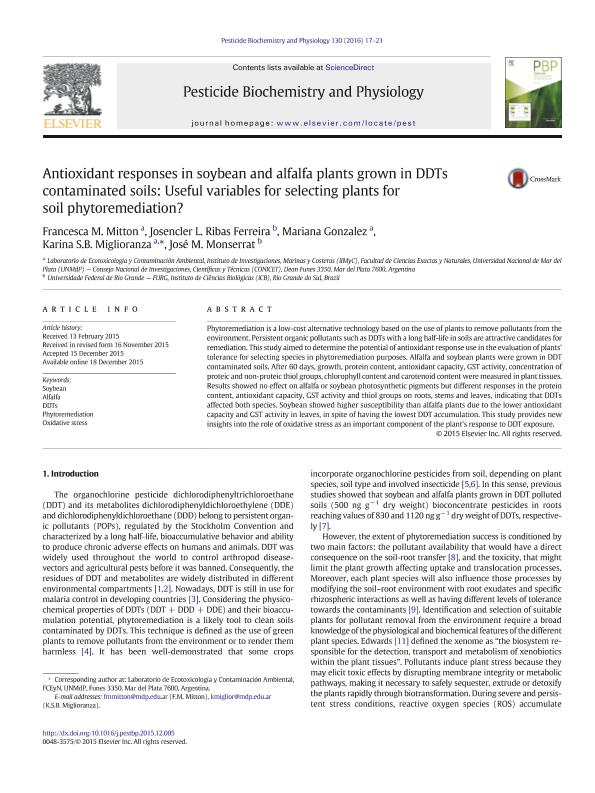Artículo
Antioxidant responses in soybean and alfalfa plants grown in DDTs contaminated soils: Useful variables for selecting plants for soil phytoremediation?
Mitton, Francesca María ; Ferreira, Josencler L. Ribas; Gonzalez, Mariana
; Ferreira, Josencler L. Ribas; Gonzalez, Mariana ; Miglioranza, Karina Silvia Beatriz
; Miglioranza, Karina Silvia Beatriz ; Monserrat, José María
; Monserrat, José María
 ; Ferreira, Josencler L. Ribas; Gonzalez, Mariana
; Ferreira, Josencler L. Ribas; Gonzalez, Mariana ; Miglioranza, Karina Silvia Beatriz
; Miglioranza, Karina Silvia Beatriz ; Monserrat, José María
; Monserrat, José María
Fecha de publicación:
06/2016
Editorial:
Academic Press Inc Elsevier Science
Revista:
Pesticide Biochemistry And Physiology
ISSN:
0048-3575
Idioma:
Inglés
Tipo de recurso:
Artículo publicado
Clasificación temática:
Resumen
Phytoremediation is a low-cost alternative technology based on the use of plants to remove pollutants from the environment. Persistent organic pollutants such as DDTs with a long half-life in soils are attractive candidates for remediation. This study aimed to determine the potential of antioxidant response use in the evaluation of plants' tolerance for selecting species in phytoremediation purposes. Alfalfa and soybean plants were grown in DDT contaminated soils. After 60 days, growth, protein content, antioxidant capacity, GST activity, concentration of proteic and non-proteic thiol groups, chlorophyll content and carotenoid content were measured in plant tissues. Results showed no effect on alfalfa or soybean photosynthetic pigments but different responses in the protein content, antioxidant capacity, GST activity and thiol groups on roots, stems and leaves, indicating that DDTs affected both species. Soybean showed higher susceptibility than alfalfa plants due to the lower antioxidant capacity and GST activity in leaves, in spite of having the lowest DDT accumulation. This study provides new insights into the role of oxidative stress as an important component of the plant's response to DDT exposure.
Palabras clave:
Alfalfa
,
Ddts
,
Oxidative Stress
,
Phytoremediation
,
Soybean
Archivos asociados
Licencia
Identificadores
Colecciones
Articulos(IIMYC)
Articulos de INSTITUTO DE INVESTIGACIONES MARINAS Y COSTERAS
Articulos de INSTITUTO DE INVESTIGACIONES MARINAS Y COSTERAS
Citación
Mitton, Francesca María; Ferreira, Josencler L. Ribas ; Gonzalez, Mariana; Miglioranza, Karina Silvia Beatriz; Monserrat, José María; Antioxidant responses in soybean and alfalfa plants grown in DDTs contaminated soils: Useful variables for selecting plants for soil phytoremediation?; Academic Press Inc Elsevier Science; Pesticide Biochemistry And Physiology; 130; 6-2016; 17-21
Compartir
Altmétricas



